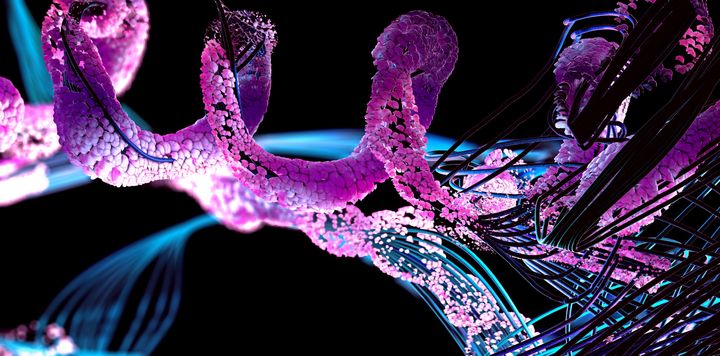New weapon against dementia: "In just minutes, the AI solves a challenge that would take neuroscientists weeks."
The clumping of proteins is at the root of a wide range of neurodegenerative disorders that affect the brain such as Alzheimer's and dementia. Researchers at the University of Copenhagen have developed a new tool that can help find and study these tiny protein clumps. The results pave the way for a greater understanding of the body's smallest building blocks and better treatment of diseases like cancer, Alzheimer's and Parkinson's.

Nearly 100,000 Danes over the age of 65 and more than 55 million people around the world live with dementia-related disorders such as Alzheimer's and Parkinson's. These diseases arise when some of the smallest building blocks in the body clump together and destroy vital functions. Why this occurs and how to treat it remains a scientific mystery. Until now, studying the phenomenon has been very challenging and limited due to an absence of the right tools.
Now, researchers from the Hatzakis lab at the University of Copenhagen’s Department of Chemistry have invented a machine learning algorithm that can track clumping under the microscope in real-time. The algorithm can automatically map and track the important characteristics of the clumped-up building blocks that cause Alzheimer's and other neurodegenerative disorders. Until now, doing so has been impossible.
"In just minutes, our algorithm solves a challenge that would take researchers several weeks. That it will now be easier to study microscopic images of clumping proteins will hopefully contribute to our knowledge, and in the long term, lead to new therapies for neurodegenerative brain disorders," says PhD Jacob Kæstel-Hansen from the Department of Chemistry, who, alongside Nikos Hatzakis, led the research team behind the algorithm.
The research has been published in the prestigious scientific journal Nature Communications.
Microscopic proteins detected in no time
The coming together and exchange of compounds and signals among proteins and other molecules occurs billions of times within our cells in natural processes that allow our bodies function. But when errors occur, proteins can clump together in ways that interfere with their ability to work as intended. Among other things, this can lead to neurodegenerative disorders in the brain and cancer.
The researchers' machine learning algorithm can spot protein clumps down to a billionth of a meter in microscopy images. At the same time, the algorithm can count and then group clumps according to their shapes and sizes, all while tracking their development over time. The appearance of clumps can have a major impact on their function and how they behave in the body, for better or worse.
"When studying clumps through a microscope, one quickly sees, for example, that some are rounder, while others have filamentous structures. And, their exact shape can vary depending on the disorder they trigger. But to sit and count them manually many thousands of times takes a very long time, which could be better spent on other things," says Steen Bender from the Department of Chemistry, the article’s first author.
In the future, the algorithm will make it much easier to learn more about why clumps form so that we can develop new drugs and therapies to combat these disorders.
"The fundamental understanding of these clumps depends on us being able to see, track and quantify them, and describe what they look like over time. No other methods can currently do so automatically and as effectively," he says.
Tools are freely available to everyone
The Department of Chemistry researchers are in now in full swing using the tool to conduct experiments with insulin molecules. As insulin molecules clump, their ability to regulate our blood sugar weakens.
"We see this undesirable clumping in insulin molecules as well. Our new tool can let us see how these clumps are affected by whatever compounds we add. In this way, the model can help us work towards understanding how to potentially stop or transform them into less dangerous or more stable clumps," explains Jacob Kæstel-Hansen.
Thus, the researchers see great potential in being able to use the tool to develop new drugs once the microscopic building blocks have been clearly identified. The researchers hope that their work will kickstart the gathering of more comprehensive knowledge about the shapes and functions of proteins and molecules.
"As other researchers around the world begin to deploy the tool, it will help create a large library of molecule and protein structures related to various disorders and biology in general. This will allow us to better understand diseases and try to stop them," concludes Nikos Hatzakis from the Department of Chemistry.
The algorithm is freely available on the internet as open source and can be used by scientific researchers and anyone else working to understand the clumping of proteins and other molecules.
The research was conducted by: Steen W.B. Bender, Marcus W. Dreisler, Min Zhang, Jacob Kæstel-Hansen and Nikos S. Hatzakis from the Department of Chemistry with support from the Novo Nordisk Foundation Center for Optimised Oligo Escape and Control of Disease.
Nøgleord
Kontakter
Jacob Kæstel-Hansen
PhD
Department of Chemistry
University of Copenhagen
jkh@chem.ku.dk
Nikos Hatzakis
PhD
Department of Chemistry
Center for Optimised Oligo Escape and Control of Disease
University of Copenhagen
hatzakis@chem.ku.dk
Michael Skov Jensen
Journalist and team coordinator
The Faculty of Science
University of Copenhagen
+ 45 93 56 58 97
msj@science.ku.dk
Følg pressemeddelelser fra Københavns Universitet
Skriv dig op her, og modtag pressemeddelelser på e-mail. Indtast din e-mail, klik på abonner, og følg instruktionerne i den udsendte e-mail.
Flere pressemeddelelser fra Københavns Universitet
KU-forskere indtager forsiden af Nature: Løser mysteriet om universets røde prikker14.1.2026 17:00:00 CET | Pressemeddelelse
Siden James Webb-teleskopet gik i luften, har røde prikker på billederne forundret videnskabsfolk verden over. Nu kan forskere fra Københavns Universitet forklare de gådefulde prikker, som gemmer på de voldsomste kræfter i universet skjult i en puppe af gas. Opdagelsen er udgivet i Nature i dag (onsdag d. 14/1.)
Ny forening sikrer stærkt fundament under Innovation District Copenhagen14.1.2026 08:00:00 CET | Pressemeddelelse
Innovation District Copenhagen skal være et internationalt kraftcenter for innovation og skal samle forskere, klinikere, iværksættere og virksomheder, så der udvikles flere nye løsninger og flere virksomheder inden for bl.a. life science og kvanteteknologi. En bred partnerkreds stifter nu en forening, der skal understøtte en langsigtet og bæredygtig udvikling af distriktet. Foreningen stiftes af repræsentanter fra stat, kommune, forskningsinstitutioner, sundhedssektor, erhvervsliv, finans, fonde og innovationsaktører. Med i stifterkredsen er Københavns Universitet
Danish chemist's invention could make counterfeiting a thing of the past8.1.2026 09:40:09 CET | Pressemeddelelse
Every year, companies lose billions of kroner when goods are copied or illegally resold. But a new digital and legally binding fingerprint developed at the University of Copenhagen makes products impossible to counterfeit. Royal Copenhagen is among the first brands in the world to use the solution.
Groundbreaking Mapping: How Many Ghost Particles All the Milky Way’s Stars Send Towards Earth8.1.2026 08:23:24 CET | Press release
Every second, a trillion of the elusive ghost particles, the neutrinos, pass straight through your body. Now, astrophysicists from the University of Copenhagen have mapped how many ghost particles all the stars in the Milky Way send towards Earth, and where in the galaxy they originate. This new map could help us track down these mysterious particles and unlock knowledge about our Galaxy that has so far been out of reach.
Banebrydende kortlægning: Så mange spøgelsespartikler sender alle Mælkevejens stjerner mod Jorden8.1.2026 08:15:33 CET | Pressemeddelelse
Hvert sekund passerer en trillion af de gådefulde spøgelsespartikler, neutrinoer, gennem din krop. Nu har astrofysikere fra Københavns Universitet kortlagt, hvor mange spøgelsespartikler alle Mælkevejens stjerner sender mod Jorden, og hvor i galaksen de kommer fra. Det nye kort kan hjælpe os med at finde de mystiske partikler og muligvis få hidtil utilgængelig viden om vores galakse.
I vores nyhedsrum kan du læse alle vores pressemeddelelser, tilgå materiale i form af billeder og dokumenter samt finde vores kontaktoplysninger.
Besøg vores nyhedsrum